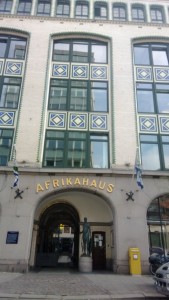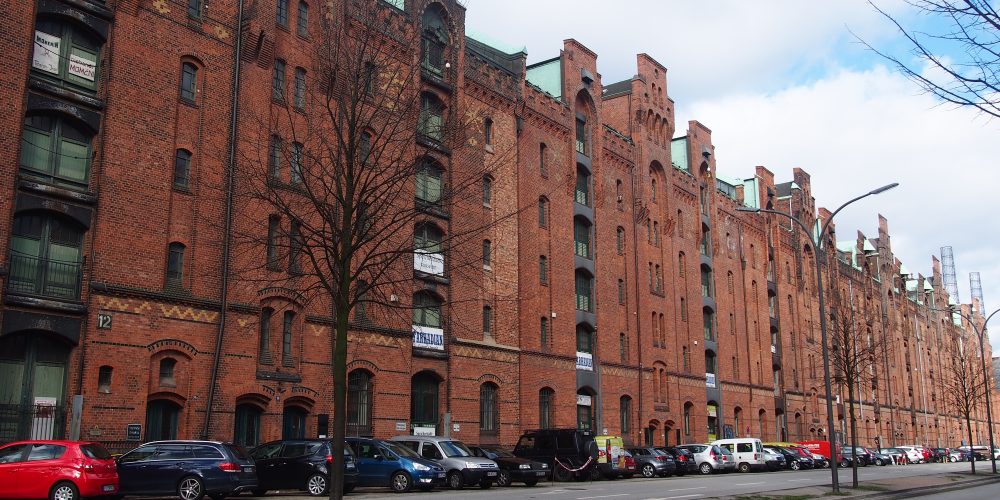 On February 12, 2015, I set off with a group of business people from Baumwall at 7 p.m. to give these “Hamburgers” a closer look at their city. We had come together to “bridge” the time until dinner at 8:15 pm. Due to the proximity, we entered the world’s largest warehouse complex on stilts via the Niederbaumbrücke. It is located directly behind the Baumwall subway station, which is part of Hamburg’s oldest elevated railway line. Art in public spaces is otherwise so easily overlooked that I first had to draw my Hamburg guests’ attention to the oriental carpet made of mosaic tiles. Of course, I also explained the construction of the warehouses and the problems that exist in the Speicherstadt and HafenCity due to the tidal range and flooding. The long history of the Elbphilharmonie was not neglected either. Although this symbol of Hamburg is on everyone’s lips, I was able to report news in this area. Escape routes, flood and fire protection were other topics we discussed. The contrast between the old (partially reconstructed) warehouses and the modern HafenCity was wonderful to see. Passing the Hamburg Dungeon, the Miniature Wonderland and the old crane that remains as a monument here in the former port, we reached Deichstraße, the fateful street of 1842, as this is where the Great Fire broke out, destroying so much of Hamburg’s old town at the time. However, some old half-timbered houses can still be seen there. We looked at this street both from the side of the Nikolaifleet and from the land and continued our walk towards Hopfenmarkt. Once here, we took a look at the
On February 12, 2015, I set off with a group of business people from Baumwall at 7 p.m. to give these “Hamburgers” a closer look at their city. We had come together to “bridge” the time until dinner at 8:15 pm. Due to the proximity, we entered the world’s largest warehouse complex on stilts via the Niederbaumbrücke. It is located directly behind the Baumwall subway station, which is part of Hamburg’s oldest elevated railway line. Art in public spaces is otherwise so easily overlooked that I first had to draw my Hamburg guests’ attention to the oriental carpet made of mosaic tiles. Of course, I also explained the construction of the warehouses and the problems that exist in the Speicherstadt and HafenCity due to the tidal range and flooding. The long history of the Elbphilharmonie was not neglected either. Although this symbol of Hamburg is on everyone’s lips, I was able to report news in this area. Escape routes, flood and fire protection were other topics we discussed. The contrast between the old (partially reconstructed) warehouses and the modern HafenCity was wonderful to see. Passing the Hamburg Dungeon, the Miniature Wonderland and the old crane that remains as a monument here in the former port, we reached Deichstraße, the fateful street of 1842, as this is where the Great Fire broke out, destroying so much of Hamburg’s old town at the time. However, some old half-timbered houses can still be seen there. We looked at this street both from the side of the Nikolaifleet and from the land and continued our walk towards Hopfenmarkt. Once here, we took a look at the
 Trade in the Middle Ages, the Vierlanden district and, of course, the fate of St. Nicholas Church, the ruins of which we also took a brief look at. We walked past the Old Town Hall and the Old Stock Exchange across the Trostbrücke bridge towards Domplatz. As we walked to Grosse Reichenstrasse, my guests learned more about the inner city development before the Great Fire, about the Gängeviertel. We also inspected the Africa House, which prompted us to talk not only about the trade in goods, but also about the slave trade in Hamburg. The cold was already beginning to gnaw at our bodies, so it was good time management that the last thing we talked about at 8:10 p.m. at the Old Fish Market was the former St. Mary’s Cathedral, which was demolished in the 19th century, and the various religions and denominations of Hamburg. We made our way to our evening restaurant in an entertaining way. The Apotheke am Alten Fischmarkt no longer serves medicine, but fresh, home-made and incredibly tasty burgers and cocktails.
Trade in the Middle Ages, the Vierlanden district and, of course, the fate of St. Nicholas Church, the ruins of which we also took a brief look at. We walked past the Old Town Hall and the Old Stock Exchange across the Trostbrücke bridge towards Domplatz. As we walked to Grosse Reichenstrasse, my guests learned more about the inner city development before the Great Fire, about the Gängeviertel. We also inspected the Africa House, which prompted us to talk not only about the trade in goods, but also about the slave trade in Hamburg. The cold was already beginning to gnaw at our bodies, so it was good time management that the last thing we talked about at 8:10 p.m. at the Old Fish Market was the former St. Mary’s Cathedral, which was demolished in the 19th century, and the various religions and denominations of Hamburg. We made our way to our evening restaurant in an entertaining way. The Apotheke am Alten Fischmarkt no longer serves medicine, but fresh, home-made and incredibly tasty burgers and cocktails.

